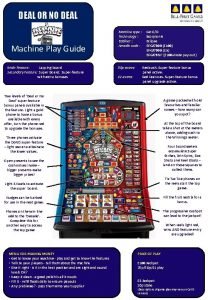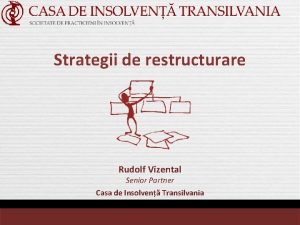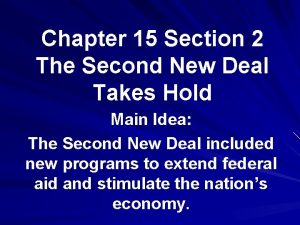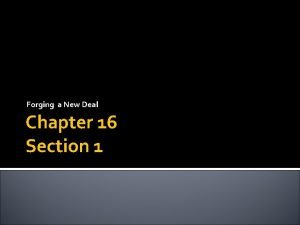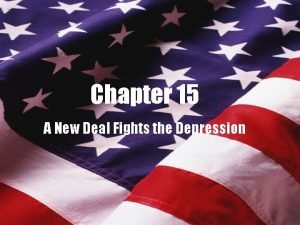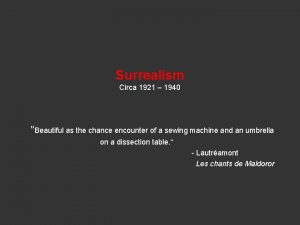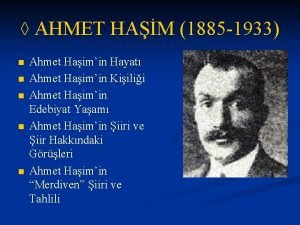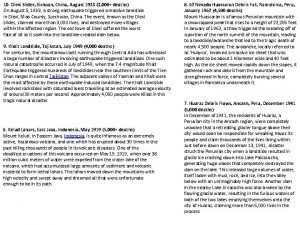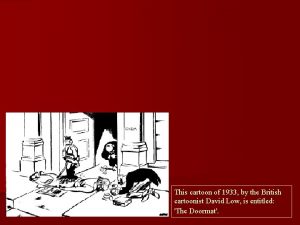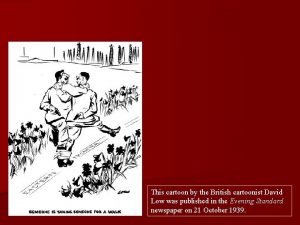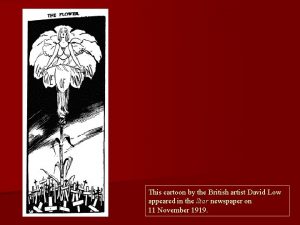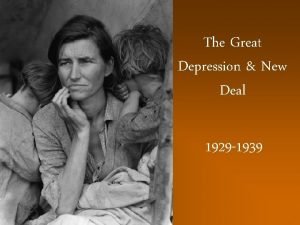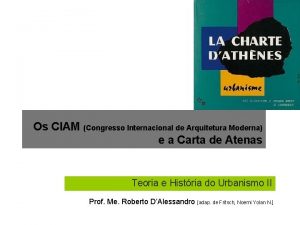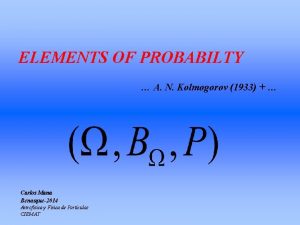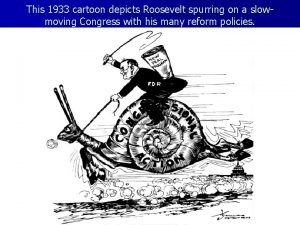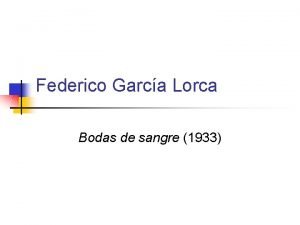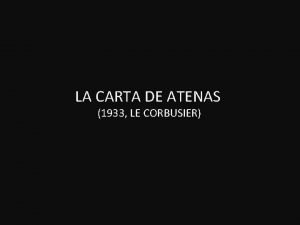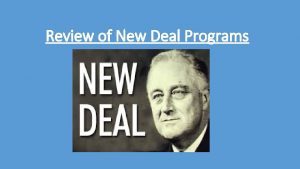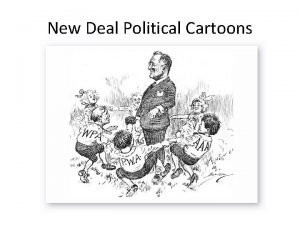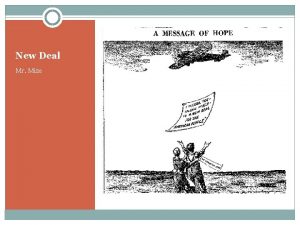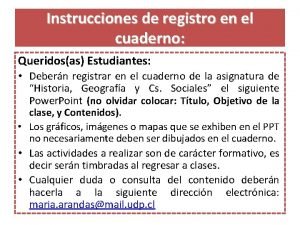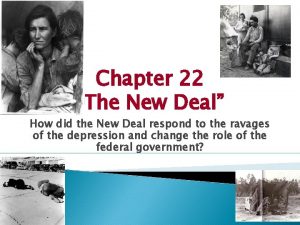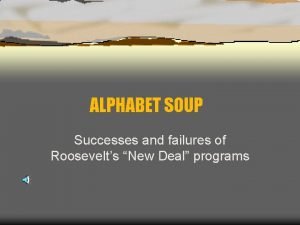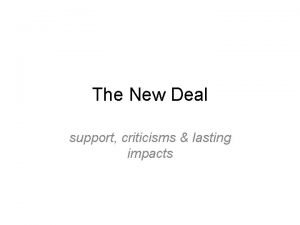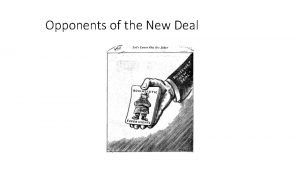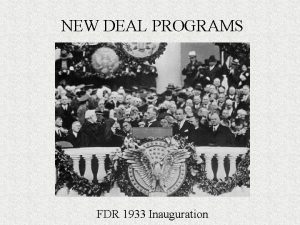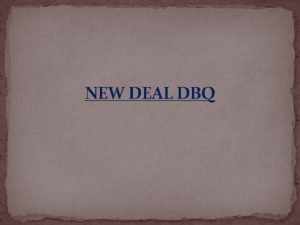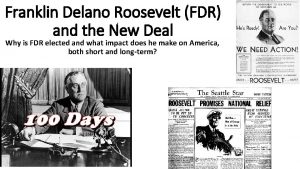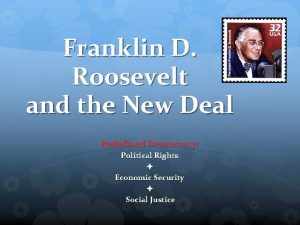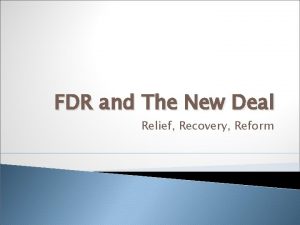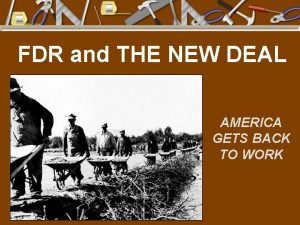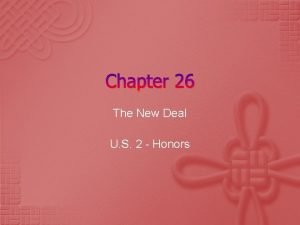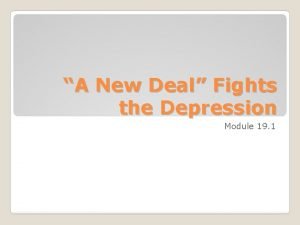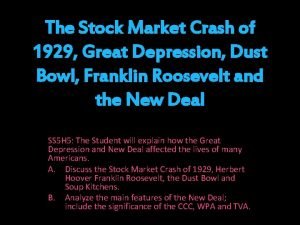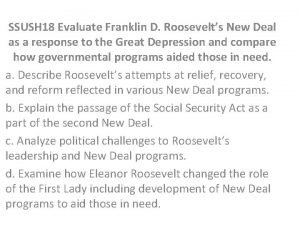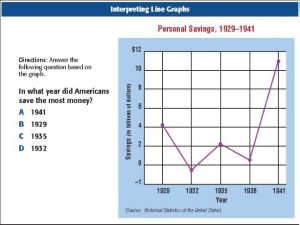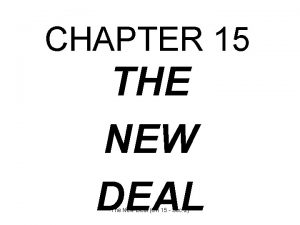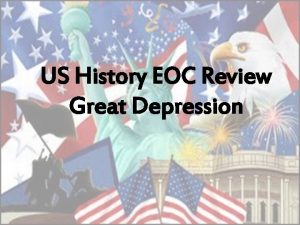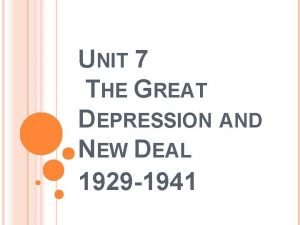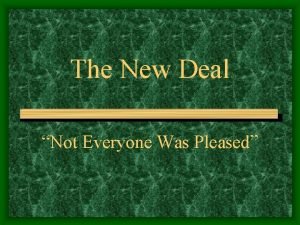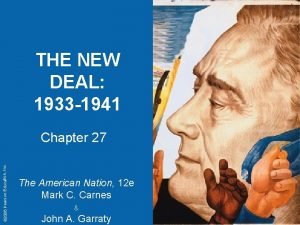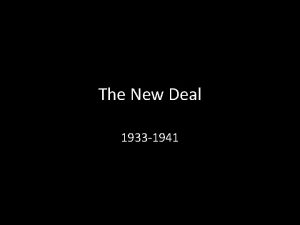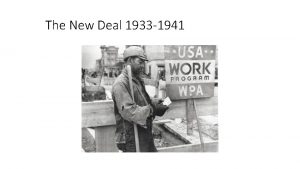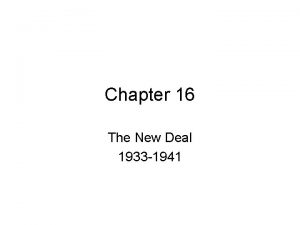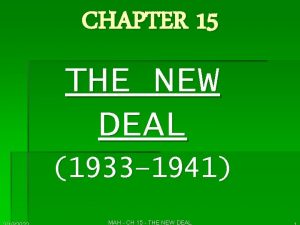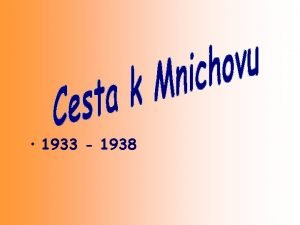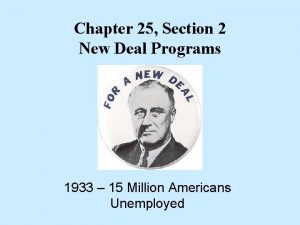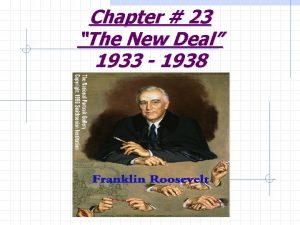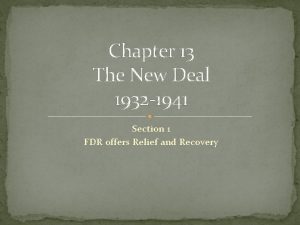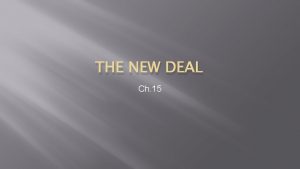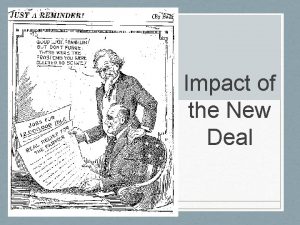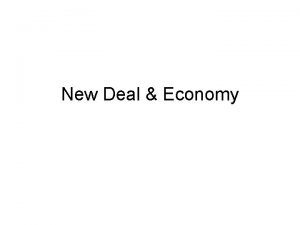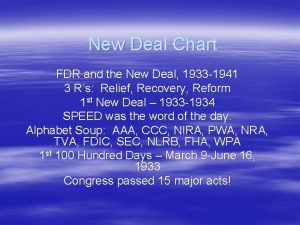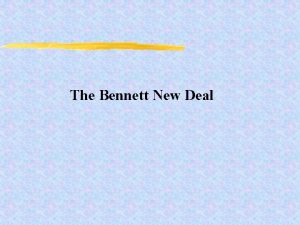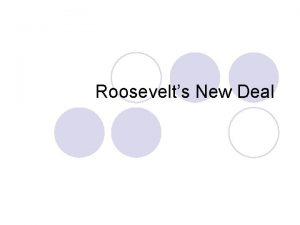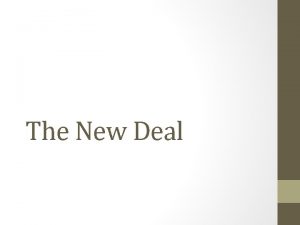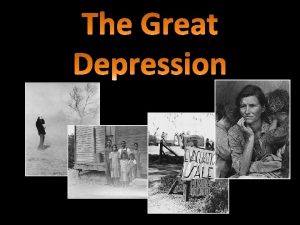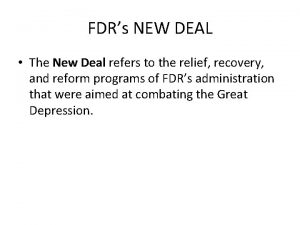Ch 16 The New Deal 1933 1941 Section





















































- Slides: 53

Ch. 16: The New Deal (1933 -1941)

Section 1: Forging a New Deal n FDR campaigned and took office on the promise of offering the country a “new deal” between the citizens and their government. A deal in which the government responded to citizens needs.

Restoring Hope Both FDR and Eleanor exuded optimism. n In his inaugural address, FDR stated that “the only thing we have to fear is fear itself. ” n Eleanor went to visit the angry Bonus Army and when she left they thanked her and wished her good luck. n

Stabilizing Financial Institutions FDR took quickly passed emergency programs within just his first 100 days of office. n The Emergency Banking Actauthorized government to inspect banks. n – Most banks were deemed secure and reopened. n Passed Glass-Steagall Banking Act of 1933 – Established the Federal Deposit Insurance Corporation (FDIC), which insures bank deposits.

Stock Market Regulation n Congress passed the Federal Securities Act. – Required companies to provide information about their finances if selling shares to public. n FDR took the country off the gold standard, which caused inflation, thus raising the prices of farm products and devalued debt.

Relief and Job Creation: FERA To provide relief for those in need, Congress passed the Federal Emergency Relief Administration (FERA). n To put people to work, the FERA started numerous public works programs. – Civil Works Administration (CWA) n § Gave unemployed people work building or improving roads, parks, airports, and other facilities. § Employed 4 million people

Civilian Conservation Corps (CCC) § Gave 2. 5 million young, unmarried men work maintaining forests, beaches, and parks. § Earned only $30/month but lived in camps free of charge and received food, medicine, and job training.

Regulating the Economy The National Recovery Administration (NRA) was established to regulate industry. n The NRA regulated wages, working conditions, production, prices, and set minimum wage. n Gave organized labor increased bargaining rights. n

Public Works Administration (PWA) n The Public Works Administration (PWA) was founded to offer employment and build large federal projects. – Grand Coulee Dam in Washington State – NYC’s Triborough Bridge – Connecter from Key West to mainland Florida.

Assisting Homeowners and Farmers The Home Owners’ Loan Corporation (HOLC) refinanced mortgages to make payments more manageable. n The Agricultural Adjustment Administration (AAA) raised farm prices through subsidies, government financial aid. n AAA paid farmers NOT to raise certain crops, to reduce supply and raise prices. n

Tennessee Valley Authority (TVA) n n Aided an undeveloped part of the country, the Tennessee and Appalachia region. Reactivated and improved a hydroelectric plant started during WWI. The TVA provided electric power, flood control, and recreational opportunities to the entire Tennessee River valley. Not only provided jobs, but helped develop the entire region.

Key Players in the New Deal Roosevelt leaned on his “brain trust”, a group of intellectuals who helped develop policies. n FDR appointed the first ever woman to a Cabinet post, Frances Perkins (Secretary of Labor). n African American, Mary Mc. Leod Bethune, held the highest position in government for an AA to that point, as director of the Division of Negro Affairs, a part of the National Youth Administration. n

Eleanor Roosevelt Eleanor was integral to FDR’s early success. n Due to his secret handicap, Eleanor often traveled and provided a public presence when FDR could not. n She pushed social limits n – Once, in the South, she sat in the center aisle separating blacks and whites in an auditorium, protesting Jim Crow segregation laws.

Early Results By 1934, it was evident that most people were supportive of the New Deal and FDR’s attempts at change, though the new programs failed to bring significant change. n Some people criticized the New Deal as giving the President new, unregulated and unwarranted power. n

Second New Deal n Midterm elections of 1934 showed strong support for FDR. n In 1935, he launched a new, even bolder series of legislation and programs. n This became known as the Second New Deal, and it further intensified the changes of the first New Deal.

Works Progress Administration (WPA) Set up in 1935, lasted 8 years and provided work for 8 million people. n Built tens of thousands of schools, hospitals, playgrounds, etc. n

Rural Electrification Founded the Rural Electrification Administration (REA) n Attempted to extend power lines to rural farmers and homeowners. n The REA brought power to 98 percent of U. S. farms. n

Labor Legislation n n Congress passed the Wagner Act, after New York Senator Robert Wagner. The Wagner Act legalized union practices like closed shopsworkplaces open only to union members. Banned employer spying and blacklisting of union employees. The Act set up the National Labor Relations Board (NLRB) to reinforce the laws.

Social Security Congress passed the Social Security Act, which established the Social Security system. n Provided regular payments to the following… n – everyone over 65 years old – Unemployed – dependent children, the blind, and the disabled

1936 Election Although FDR was expected to win, he shocked the world with the margin of his victory. n Won every state but Vermont and Maine, won 523 -8. n His popularity demonstrated Americans’ support for the New Deal’s responsiveness to need. n

Section 2: The New Deal’s Critics n Those who benefited from the New Deal believed FDR to be a hero. Others thought the New Deal either went too far, or not far enough.

New Deal Does Too Little n Some people thought that the New Deal didn’t do enough to help suffering Americans. n For example, the new minimum wage set at 25 cents an hour was lower than most employees made anyway.

Then v. Now: Government not doing enough n Then- FDR critics – Unemployment still high – Government should increase business regulation – Minimum wage too low – No opportunities for women or African Americans n Now: Obama critics – Unemployment still high – Not enough public work projects to put people to work – Not enough stimulus money – Healthcare reform not drastic enough

Women The New Deal disproportionately benefited men more than women. n NRA codes allowed lower wages for women’s work in many cases. n In relief programs, men and boys received preference. n Jobs went to male “heads of families”. n

African Americans n n Federal relief programs in the South reinforced segregation. Kept out of skilled jobson dam and electric projects. Received lower pay for doing the same work. With jobs scare and discrimination strong, finding work became exceptionally difficult for African Americans.

New Deal Does Too Much n Other critics believed that the New Deal did too much. n Believed FDR was becoming too powerful. n Opposed the expanded power of the Federal Government. – Thought public works programs were socialistic. n FDR raised taxes on the rich.

American Liberty League In 1934, American Liberty League was founded to oppose the New Deal. n Led by former Democratic presidential candidate, Alfred E. Smith. n The league charged the New Deal with limiting individual freedom in an “un. American”, communist leaning fashion. n

Father Coughlin n n Father Charles E. Coughlin used the radio to reach an audience of 10 million people by 1934. A dynamic, passionate speaker, the “Radio Priest” first supported the New Deal, then vehemently attacked it. By the end of the 1930 s, Coughlin was issuing openly anti-Jewish statements and praised Adolf Hitler and Benito Mussolini, and lost much of his support. In 1942, Roman Catholic officials ordered him to stop his show.

Huey Long: The Kingfish n n n Powerful, revolutionary, and controversial figure in Louisiana politics. Long grew up in poverty, became the Louisiana governor in 1928 and a U. S. senator in 1932. Forcefully advanced his agenda to redistribute wealth. Extremely popular among the lower class. Feared and criticized by many for his dictatorial tendencies and power.

Huey Long: The Kingfish Developed a program called Share-Our-Wealth in which government would redistribute wealth with steep progressive taxes. n Long was a democrat, but an opponent to FDR’s New Deal, believed it wasn’t radical enough. n Long was considering a run for presidency when he was assassinated in 1935. n

Modern-Day Critics n Today, the New Deal is generally perceived to have successfully lifted the country out of Depression, but some critics view it as a negative turning point for the country’s government.

Modern Criticisms n n Expanded the power, size, and role of Federal Government Threatened American principles of free enterprise (laissez-faire) Created “make work” jobs instead of letting the free market determine work needs Relied on deficit spending; increased National Debt

Then v. Now Government Doing Too Much n Then: FDR critics – Expanded government & socialistic programs (public works programs, social security program) – Too much government regulation of business – Raising taxes on rich – Deficit spending n Now: Obama critics – Expanded government & socialistic programs (stimulus package, health care) – Too much government regulation in business – Raising taxes on rich – Deficit spending

Comparisons

Court-Packing n n n Roosevelt also received criticism for attempting to “pack” the Supreme Court with judges supportive of the New Deal. The Constitution doesn’t specify the number of Supreme Court justices. Since 1869, there had always been nine justices.

Court-Packing n n FDR received some early opposition from the nine Supreme Court justices. He proposed adding six additional members to the Supreme Court, one per justice over 70 years old, to lighten their load. His intention was to “pack” the Court with judges supportive of the New Deal. He received harsh criticism from both sides and withdrew his reform bill.

Court-Packing

Section 3: Last Days of the New Deal

Recession of 1937 n After a period of temporary improvement, the economy collapsed again in 1937. n In attempt to balance the budget… – FDR cut back government spending on programs that provided work for Americans – Raised taxes n Both these actions reduced money circulation and sent the economy into recession.

Unions Triumph n The 1935 Wagner Act made union membership more attractive. n Membership rose from 3 million in 1933 to 10. 5 million in 1941.

New Labor Organization The American Federation of Labor (AFL) had done little to attract new members. n John L. Lewis helped create a Committee for Industrial Organization (CIO) within the AFL. n AFL didn’t support the CIO, which recruited unskilled industrial workers. n The AFL suspended the CIO in 1936, they changed their name to the Congress of Industrial Unions and soon had more than 4 million members. n – John L. Lewis served as president.

Strikes The Wagner Act legalized collective bargaining, leading to new union demands and strikes. n The Congress of Industrial Organizations used a new strike method n – Sit-down strikes: workers refused to work but didn’t leave the building, preventing the company from hiring “scabs”, non-union replacement workers.

GM Sit-down strike n n Strikers occupied General Motor’s main plants in Flint, Michigan. GM turned off the heat, blocked external food supplies, and called in police to break up outside picketers and violence erupted. Wives of the strikers organized food deliveries and formed a Women’s Emergency Brigade to continue picketing outside. Government did not break up the strike and eventually GM gave in.

New Deal Cultural Legacies: Literature n n The Good Earth, by Pearl Buck (1931) – A book about peasant struggle in China The Grapes of Wrath, by John Steinbeck (1939) – Dust Bowl victims who travel to California in search of a better life n Let Us Now Praise Famous Men (1941) – James Agee and Walker Evans of Fortune magazine Lived among Alabama sharecroppers and wrote of their experiences

Radio was increasingly popular n “soap operas” appear, named after the soap companies that sponsor them. n Short, 15 -minute stories that provoke strong emotions. n

“Fireside Chats” n FDR’s attempt to restore Americans’ faith in the economy and government.

Movies presented an escape from hard times for those who could afford them at all. n Drive-in theaters introduced in 1933 n n Mr. Smith Goes to Washington (1939) – A common man overcomes the corrupt, entrenched political system in Washington n The Wizard of Oz (1939) – Walt Disney begins releasing cartoons.

WPA and the Arts FDR believed the arts to be not luxuries, but essential to human flourishing. n He earmarked WPA funds to support unemployed artists, musicians, historians, theater people, and writers. n Federal Writers’ Project n – Assisted more than 6, 000 writers n Federal Music Project – Organized community orchestras and free lessons

Federal Art Project n Employed artists to produce 2, 000 murals, 100, 000 paintings, and 17, 000 sculptures

Lasting Achievements n While the New Deal era is considered to end with America’s entrance into WWII, the New Deal left significant, lasting influence on the U. S. identity.

Public Works and Federal Agencies n Public works programs built much of our infrastructure today; roads, bridges, dams, tunnels, and hospitals remain. n Key agencies remain – The Federal Deposit Insurance Company (FDIC) – Securities and Exchange Commission (SEC)

Social Security has become a foundation to the U. S. economic and retirement system. n Largest social welfare program in the U. S. n Has undergone significant revisions, but the concept remains the same. n

Legacy of Hope Above all, the New Deal restored the confidence of many Americans in the country and their government. n FDR represented someone who cared about people’s individual needs. n
 Deal or no deal machine
Deal or no deal machine Rudolf vizental
Rudolf vizental Chapter 15 section 3 the new deal affects many groups
Chapter 15 section 3 the new deal affects many groups Chapter 15 section 2 the second new deal
Chapter 15 section 2 the second new deal Forging a new deal section 1 answers
Forging a new deal section 1 answers The new deal fights the depression
The new deal fights the depression Minotauro man ray
Minotauro man ray Seyreyledim eşkal-i hayatı ben havz-ı hayalin sularında
Seyreyledim eşkal-i hayatı ben havz-ı hayalin sularında Diexi slides
Diexi slides British cartoon by david low 1934
British cartoon by david low 1934 Rendezvous political cartoon meaning
Rendezvous political cartoon meaning Cartoon by david low 1933
Cartoon by david low 1933 National industrial recovery act of 1933
National industrial recovery act of 1933 Ciam urbanismo
Ciam urbanismo Kolmogorov 1933
Kolmogorov 1933 Objective liability offences
Objective liability offences British cartoon by david low 1934
British cartoon by david low 1934 Cartoon 1933
Cartoon 1933 Bodas de sangre 1933
Bodas de sangre 1933 Brasilia carta de atenas
Brasilia carta de atenas Dahilan ng ikalawang digmaan
Dahilan ng ikalawang digmaan Csci 1933 umn
Csci 1933 umn Aaa new deal logo
Aaa new deal logo The new deal an alphabet soup of agencies
The new deal an alphabet soup of agencies John steinbeck apush
John steinbeck apush Aaa new deal purpose
Aaa new deal purpose New deal political cartoon
New deal political cartoon Rrr new deal
Rrr new deal New deal esquema
New deal esquema Emergency banking relief act (ebra)
Emergency banking relief act (ebra) The ingenious quarterback analysis
The ingenious quarterback analysis New deal alphabet soup
New deal alphabet soup Lasting impacts of the new deal
Lasting impacts of the new deal Tennessee valley basin
Tennessee valley basin New deal political cartoons and explanations
New deal political cartoons and explanations New deal critic dr francis townsend
New deal critic dr francis townsend The new deal webquest
The new deal webquest New deal programs
New deal programs William lloyd garrison jr the hand of improvidence
William lloyd garrison jr the hand of improvidence New deal
New deal The new deal redefined the role of the
The new deal redefined the role of the Sec new deal relief recovery reform
Sec new deal relief recovery reform Nlra poster
Nlra poster The new deal
The new deal A new deal fights the depression
A new deal fights the depression New deal intézkedései
New deal intézkedései To introduce new just to deal
To introduce new just to deal New deal tennessee valley authority
New deal tennessee valley authority New deal program
New deal program Sec new deal
Sec new deal New deal
New deal What is the main idea of the cartoon?
What is the main idea of the cartoon? New deal
New deal New deal this everyone
New deal this everyone
